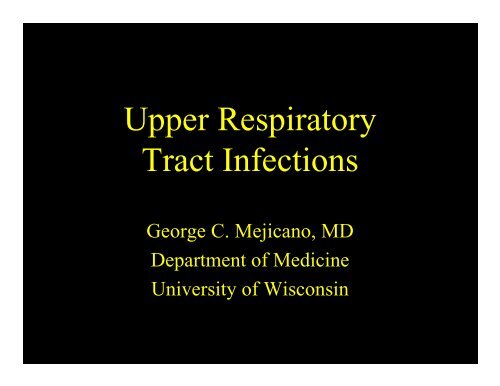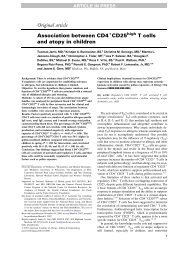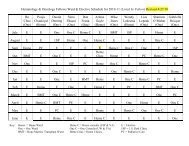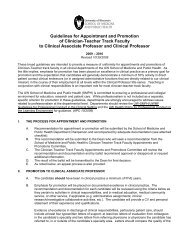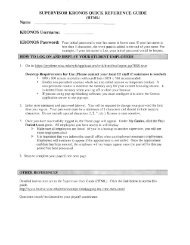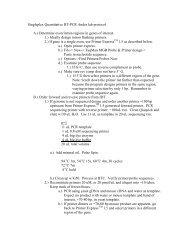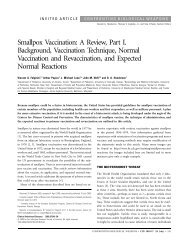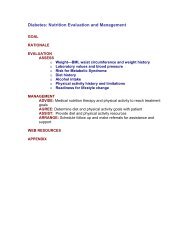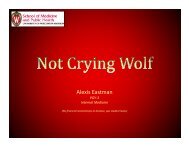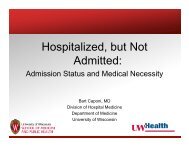Upper Respiratory Tract Infections
Upper Respiratory Tract Infections
Upper Respiratory Tract Infections
- No tags were found...
You also want an ePaper? Increase the reach of your titles
YUMPU automatically turns print PDFs into web optimized ePapers that Google loves.
<strong>Upper</strong> <strong>Respiratory</strong><strong>Tract</strong> <strong>Infections</strong>George C. Mejicano, MDDepartment of MedicineUniversity of Wisconsin
URTI’s• Sinusitis• Acute Otitis Media• Pharyngitis
Question One:What percent of adults with common coldsprogress to acute bacterial sinusitis?A) 5-10%B) 2-5%C) 0.5-2%D) 0.1-0.5%
Sinusitis• Most often a secondary infection of theparanasal sinuses which occurs because theoutflow from one of the sinuses is decreased• Common cold is really a viral rhinosinusitis– 87% of patients with common colds have CTevidence of sinus cavity disease– 0.5-2% will progress to acute bacterial sinusitis• Maxillary sinus is most often affected[J Gen Int Med 1992; 7:481] & [Clin Inf Dis 1996; 23:1209]
Impact of Sinusitis in the US• The estimated number of cases of acutebacterial sinusitis is 10-15 million per year• Approximately 10% seek medical careleading to 2 million office visits per year• Cost of medications is more than $3 billiondollars per year, not including antibioticsBartlett, 2001
Sinusitis: Predisposing Factors• Impaired mucociliary function:> viral URTI’s > cold or dry air> chemicals & drugs > cystic fibrosis> ciliary dysmotility syndrome• Obstruction of sinus ostia:> anatomic abnormalities > allergic rhinitis> rhinitis medicamentosa > viral URTI’sVortel & Chow, 1992
Sinusitis: Predisposing Factors• Immune defects:> IgA deficiency > AIDS> IgG subclass deficiency > diabetes> Wegener’s granulomatosis• Increased risk of microbial invasion:> odontogenic infection > head trauma> nasotracheal intubation > cocaine use> swimming or diving Vortel & Chow, 1992
Causes of Acute Maxillary Sinusitis• Bacterial agents Mean RangeS. pneumoniae 31% 20-35%H. influenzae 21% 6-26%S. pneumoniae & H. influenzae 5% 1- 9%M. catarrhalis 2% 2-10%• Viral agentsRhinovirus 15%Influenza 5%Parainfluenza 3%Gwaltney, 1996
Antibiotic Resistance• S. pneumoniae• mechanism: altered penicillin binding proteins• high-level and overall resistance is on the rise• incidence varies widely with location• H. influenzae• about 30% of isolates produce beta-lactamase• M. catarrhalis• over 90% of isolates produce beta-lactamaseBartlett, 1997
Microbial Causes of Sinusitis• More than half of the cases of acute sinusitisare caused by S. pneumoniae & H. influenzae• Anaerobes and S. aureus are uncommon butmay be associated with chronic sinusitis• Fungi seen in hosts with impaired immunity• Nosocomial sinusitis is most often due toGram-negative rods or S. aureusBartlett, 1999
Acute Sinusitis is Overdiagnosed• 174 patients clinically diagnosed with sinusitis,only 89 (53%) confirmed by sinus puncture• In contrast to clinical features, ESR and CRPhelped predict which patients had cultureproven sinusitis• For patients with abnormal ESR and CRP,sensitivity was 82% and specificity was 57%Hansen et al, 1995
Question Two:A 52 year old woman presents with 3 daysof headache, tooth pain, and purulent nasaldischarge unresponsive to decongestants.Her exam is normal. What do you believe?A) I’m sure this is the the common coldB) Likelihood this is sinusitis is < 40%C) Likelihood this is sinusitis is > 60%D) Can’t tell to any degree of certainty
Question Two (part 2):Would you treat this patient with anantibiotic?A) YesB) No
Features That Predict SinusitisClinical FeatureLikelihood ratio• Maxillary toothache 2.5 (1.2-5.0)• Purulent secretion by exam 2.1 (1.5-3.0)• Poor response to decongestant 2.1 (1.4-3.1)• Abnormal transillumination 1.6 (1.3-2.0)• Hx of colored nasal discharge 1.5 (1.2-1.9)[JAMA 1993; 270:1242-6]
Probability of SinusitisNumber of Predictors Probability (%)0 91 212 403 634 815 92Williams et al, 1992
Diagnosing Acute Sinusitis• If less than two of the five clinical featuresdescribed by Williams and co-workers[Ann Intern Med 1992; 117: 705] arepresent, sinusitis is effectively ruled out• If four of the five clinical features arepresent, sinusitis is effectively ruled in• If 2-3 features present, consider x-raysCanadian Sinusitis Symposium, 1997
Sinus Transillumination• In a dark room, place light source on infraorbitalrim and look at roof of the mouth•Result # of Sinuses Positive AspiratesNormal 18 1 (6%)Dull 26 7 (27%)Opaque 23 23 (100%)Gwaltney et al, 1981
X-rays and Diagnosing Sinusitis• A single Waters view is sufficientWilliams et al, 1992• Good correlation seen in only 50% (majorproblem is many false positives with x-rays)Bartlett, 2001• Air-fluid level is most reliable: in 18 patientswith this finding, 16 had positive aspiratesGwaltney et al, 1981
CT Scans in Diagnosing Sinusitis• CT is best imaging technique & limitedscans are now costing less• CT may be too sensitive:Bartlett, 2001Of 666 patients who had CT scan for eitherhead trauma or seizures, 43% had abnormalsinuses, 24% involving the maxillary sinusesHavas et al, 1988
Indications for Sinus CT Imaging• Patient is considered a candidate for surgery• Acute sinusitis with suspected intracranialor intraorbital extension• Patient with severe facial pain or headachewhen nasal endoscopy is not diagnostic• Patient fails to respond to standard therapy,including antibiotic treatmentBartlett, 2001
Cultures for Diagnosing Sinusitis• Cultures of purulent nasal dischargecontaminated by organisms in the nose• Endoscopic collection: 65% sensitive and40% specific compared to sinus aspirate• Aspirate of sinus is definitive: obtain Gramstain as well as aerobic & anaerobic cultures(fungal stain & culture if compromised)[Clin Inf Dis 1996; 123:1209] & [ICAAC 1995; Abs D42]
Indications for Sinus Aspiration• Septic or immunocompromised patient• Nosocomial infection• Poor response to therapy• Complications> meningitis > brain abscess (frontal)> periorbital cellulitis > osteomyelitis> cavernous sinus thrombosisBartlett, 1997
Management of Sinusitis• Rule out dental source and complications• Surgical management to promote drainage,remove diseased tissue, or correct ostialand/or intranasal abnormalities• Consider hospitalization if patient is acutelyill or immunocompromised, if complicationoccurs, or if the frontal sinus is involvedGoodman & Slavin, 1994
Medical Management of Sinusitis - 1• Steam can prevent nasal crusting & liquefy secretions• steam inhalation several times daily• Saline can prevent nasal crusting & liquefy secretions• saline nasal spray qid• Decongestants help to increase ostial diameter• topical oxymetazoline (0.05%) 2-3 sprays in each nostrilbid x 3 days at start of therapy; watch for rebound effect• pseudoephedrine 30-60 mg qidGoodman & Slavin, 1994
Medical Management of Sinusitis - 2• Topical steroids reduce mucosal inflammation;limit use to chronic sinusitis due to allergies• beclomethasone 2 sprays in each nostril bid• many other agents now available• Mucoevacuants thin mucous secretions• guaifenesin 600-1200 mg bid• Antibiotics eradicate bacterial infection• shown to be of benefit in numerous clinical trials• Wald et al (1986) showed placebo effect is > 40%Goodman & Slavin, 1994
Question Three:First line therapy for acute sinusitis is:A) Amoxicillin-clavulanateB) CefprozilC) LevofloxacinD) AzithromycinE) Amoxicillin
Question Three (part 2):What is the correct duration for treating acutebacterial sinusitis with antibiotics?A) Three daysB) Ten daysC) Fourteen daysD) Twenty-one days
Which Antibiotic to Choose?• Historically established• amoxicillin, doxycycline, TMP-SFX• FDA-approved for sinusitis• amoxicillin/clavulanate, cefdinir,cefpodoxime, cefprozil, cefuroxime axetil,ciprofloxacin, clarithromycin, gatifloxacin,loracarbef, levofloxacin, and moxifloxacinBartlett, 2001
Antibiotics With Proven Efficacy * byPre- and Post-treatment Aspiration• amoxicillin 500 mg po tid• amoxicillin-clavulanate 875/125 mg po bid• cefdinir 300 mg po bid• cefuroxime axetil 250-500 mg po bid• cefpodoxime 100-200 mg po bid• gatifloxacin 400 mg po q day• loracarbef 400 mg po bid• trimethoprim-sulfamethoxazole one DS po bid• levofloxacin 500 mg po q day• moxifloxacin 400 mg po q day* pathogen eradication in > 90% Bartlett, 2001
Therapy for Acute SinusitisGold standard: AmoxicillinBartlett, 2001CDC Recommendation: AmoxicillinO’Brien, 1998Amoxicillin therapy should be the firstlinetreatment of acute bacterial sinusitisCanadian Sinusitis Symposium, 1997
How Good is Amoxicillin?• Meta-analysis looking at effect of antibioticsversus placebo (and amoxicillin or TMP-SFX versus more expensive antimicrobials)– 2717 patients with acute sinusitis from 27 trials– Compared with placebo, antibiotics decreasedthe incidence of clinical failures by half (RR =0.54 with 95% confidence interval 0.37-0.79)– amoxicillin and TMP-SFX equal to the rest[BMJ 1998; 317:632-7]
First-Line vs Second-Line Antibiotics for theTreatment of Acute Uncomplicated SinusitisPicirillo JF et al. JAMA 2001; 286:1849-56Population: 29,102 healthy adults treated for acute sinusitisSource: Express Scripts medical claims and pharmaceutical dataTime Period: 1996-97Outcome: Absence of additional claim for antibiotic within 28 daysFirst Line Drugs: amoxicillin, TMP-SFX, erythromycin% SuccessfullyTreatedAverage DirectChargesFirst Line 90.1% $68.98Second Line 90.8% $135.171 complication (periorbital cellulitis) in each group
Duration of Antibiotic Therapy• Most clinical trials have used 10 -14 days• 1997 Canadian Sinusitis Symposium hasformally recommended a 10 day course• Evidence that three days may be enough:> trial of amoxicillin/clavulanate vs. amoxicillinin children with sinusitis [Wald et al, 1986]• clinical response after 3 days was equal to 10 days> 80 adults treated with TMP-SFX [Williams et al, 1995]• no difference between 3 and 10 days of therapy• all received 3 days of oxymetazoline
Guidelines for Appropriate AntibioticUse for Treatment of AcuteRhinosinusitis <strong>Infections</strong> in AdultsAnnals of Internal Medicine, March 20, 2001
Position PaperPrinciples of Appropriate Antibiotic Use forAcute Rhinosinusitis in AdultsPrinciple 1. Most cases of acute rhinosinusitisdiagnosed in ambulatory care are caused byuncomplicated viral upper respiratory tract infections.Evidence Rating: APrinciple 2. Bacterial and viral rhinosinusitis aredifficult to distinguish on clinical grounds.Evidence Rating: B
Position PaperAcute Rhinosinusitis in AdultsPrinciple 3. Sinus radiography is not recommendedfor diagnosis in routine cases.Evidence Rating: BPrinciple 4. Acute rhinosinusitis resolves withoutantimicrobial treatment in most cases.Evidence Rating: A
Position PaperAcute Rhinosinusitis in AdultsConclusions: Symptomatic treatment is the preferred initialmanagement strategy, except for patients withmoderate to severe symptoms. Patients with maxillary pain or tenderness in the faceor teeth and persistent purulent nasal discharge whoare not improving after 7 days, and those with severerhinosinusitis symptoms, should be treated withantibiotics. When an antibiotic is prescribed, it should be the mostnarrow-spectrum agent that is active against the likelypathogens.
Duration of Symptomsin 139 Rhinovirus Colds% o f patie nts w ith s ym pto m7060504030feverishnesss ore throa tcoughnasal discharge201001 2 3 4 5 6 7 8 9 10 11 12 13 14day o f illne s sGwaltney, JAMA 1967;202:158
Chronic Sinusitis> Term used when symptoms occur for > 12 weeks or> 4 episodes per year (each lasting > than 10 days),as well as CT imaging demonstrating persistentinfection despite antimicrobial therapy> Pathogenesis: osteomeatal obstruction, most oftendue to allergic or anatomic process• if allergy and ENT evaluation do not help, considerimmune work-up> Role of antimicrobial therapy is very small• use only for acute exacerbations[Bartlett, 2001]
Question Four:A 2 year old girl presents with a 1 day historyof irritability, fever, and ear pain. On examyou see a bulging & red tympanic membrane.Do you treat her with antibiotics?A) YesB) No
Acute Otitis Media• Definition: presence of fluid in the middleear accompanied by signs of acute illness• Most common pediatric problem• by age 3, more than 75% have been affected• major cause of meningitis, sepsis, and hearing loss• Predisposing factors include:• eustachian tube obstruction (URTI’s & allergies)• anatomy of child’s middle earKlein, 1994
Causes of Acute Otitis MediaS. pneumoniae 25-50%H. influenzae 15-30%M. catarrhalis 3-20%<strong>Respiratory</strong> viruses 20%S. pyogenes 2-3%S. aureus 2-3%[Clin Infect Dis 1994; 19:823-33]
Diagnosis of Acute Otitis Media• Signs & symptoms: ear pain, ear drainage,hearing loss, lethargy, irritability, & fever• Tympanic membrane is full & bulging, oftenred and immobile, occasionally perforated• Middle ear effusion determined by exam,through pneumatic otoscopy, or impedancetympanometryBerman, 1995
A: Painful, retracted eardrum (due to negative pressure and not acute otitis media)B: Bulging eardrum with purulent fluid consistent with acute otitis mediaC: Red tympanic membrane without middle ear fluid is not otitis media
Indications for Tympanocentesis•Neonates• Immunocompromised patients• Septic patients• Toxic patients despite > 2 days of therapy• Recurrent disease• Onset during antibiotic therapy• Complications: meningitis or mastoiditis
Management of Acute Otitis Media• Analgesics may help relieve symptoms• Decongestants & antihistamines are unproven• Role of antibiotics is becoming controversial• concern with emergence of resistance (Berman, 1995)• must treat 7 children to improve one (Rosenfeld, 1995)• antibiotic use associated with decrease in incidence ofmastoiditis & meningitis (Bluestone, 1995); but muchof this decline is due to the Hib vaccine (CDC, 1996)• Must follow-up patient to assess response
Therapy for Acute Otitis Media“Amoxicillin is the drug currently preferredfor initial empiric therapy of acute otitis media”Bluestone, 1995“Amoxicillin remains the drug of choice fortreatment of acute otitis media because of its20-year record of clinical success, acceptability,limited side effects and relative low cost.”Klein, 1994
1999 CDC Recommendations• Amoxicillin is still first line, regardlessof prevalence of penicillin resistance– Increasing penicillin resistance seen withS. pneumoniae so use higher dose– Dose is now 80-90 mg/kg/day x 10 days– Standard dose of 40-45 mg/kg/day may beused if risk of resistance is low (e.g. age > 2,no day care, no antibiotics in past 3 months)[Pediatr Infect Dis J 1999; 18:1-9]
1999 CDC Recommendations• Alternative agent should be consideredafter three days if amoxicillin fails• Agent should cover H. influenzae, M. catarrhalisand penicillin resistant S. pneumoniae– Cefuroxime 30 mg/kg divided bid, or– Amoxicillin-clavulanate 80-90 mg/kg/day (amoxicillincomponent 80-90 mg/kg/day with clavulanate dosingremaining at approximately 10 mg/kg/day), or– Ceftriaxone 50 mg/kg IM q day x three doses[Pediatr Infect Dis J 1999; 18:1-9]
New Amoxicillin/Clavulanate Dose• Glaxo Smith Kline has come out with a newformulation of amoxicillin-clavulanate– Indicated for pediatric patients > 3 months– Indicated for persons with acute otitis mediawithin the preceding 3 months, and either age< 2 years or daycare attendance• Augmentin ES-600– 90 mg/kg/day divided Q 12 hours x 10 days– Based on amoxicillin component (600 mg/5 ml)
Persistent Middle Ear Effusion• Seen in 70% at 2 weeks, 20% at 2 months• Associated with hearing loss• If middle ear effusion persists at 12 weeks:• antibiotic as in acute otitis media, but for 14-21days• plus prednisone 1 mg/kg/d divided bid for 1 week• If middle ear effusion persists at 16 weeks:• check audiometry; refer for tympanostomy tubesif bilateral hearing threshold > 20 dBBerman, 1995
Principles of Judicious Use ofAntimicrobial Agents for Pediatric<strong>Upper</strong> <strong>Respiratory</strong> <strong>Tract</strong> <strong>Infections</strong>•Otitis mediaS. Dowell, EditorSponsored by CDC and the American Academy of PediatricsPediatrics, January 1998, Volume 101 (supplement)
Principles forAcute Otitis Media in ChildrenPrinciple 1. Episodes of otitis media should beclassified as acute otitis media (AOM) or otitis mediawith effusion (OME).Principle 2. Diagnosis requires documented middleear effusion and signs or symptoms of acute local orsystemic illness.
Diagnostic Criteria for AOMConfirm middle ear effusion with pneumaticotoscopy or tympanometryDocument acute illness: otorrhea, bulgingyellow/red tympanic membrane, ear pain, feverRhinorrhea, cough, irritability, ear pulling arenonspecific and do NOT contribute to AOMdiagnosis
Principles forAcute Otitis Media in ChildrenPrinciple 3. Uncomplicated AOM may be treated witha 5-7 day course of antimicrobials in certain patients.Principle 4. Antimicrobials are not indicated for initialtreatment of OME; treatment may be indicated ifeffusions persist 3 months or more.
Principles forAcute Otitis Media in Children Most episodes of acute otitis media (AOM) are selflimited,although antibiotics provide some benefit. Amoxicillin remains the drug of choice for initialtreatment of uncomplicated AOM.– 80-90 mg/kg/day recommended to eradicate S. pneumoniaewith intermediate resistance Short course (or lower dose) appropriate for children atlow risk for treatment failure:– ≥ 24 months old– not in day care– no antibiotic use past 3 months
Principles forAcute Otitis Media in ChildrenPrinciple 5. Persistent middle ear effusion (OME)after therapy for AOM is expected and does notrequire re-treatment.Principle 6. Antimicrobial prophylaxis should bereserved for control of recurrent AOM, defined by >3distinct episodes per 6 months or > 4 episodes per 12months.
Recurrent Otitis Media• Definition: > 3 episodes in previous 6 months• Antibiotic prophylaxis (for 3 to 6 months)• Amoxicillin 20 mg/kg/d in one dose• Sulfisoxazole 75 mg/kg/d in one dose• Immunizations• Pneumovax may help if > 2 years of age• Yearly influenza vaccine[NEJM 1995; 332:1560-5]
New Vaccine for S. pneumoniae• Conjugate 7-valent vaccine targeted atS. pneumoniae was approved in 2000– Doses at 2, 4, 6 and 12-15 months• Vaccine efficacy:– 97% reduction in bacteremia and meningitis– 73% reduction in pneumonia– 34% reduction in otitis media[Infectious Disease News, 1999][MMWR 2000; 49(RR-9):1-35]
Question Five:An 18 year old man presents with sudden onsetof fever and sore throat on Friday. You seepatchy exudates over the tonsils but the rapidstrep screen is negative. Do you get a culturein case the rapid detection test is negative?A) YesB) No
Causes of Pharyngitis• Rhinovirus 20%• Coronavirus > 5%• Adenovirus 5%• Herpes simplex virus 4%• Group A Streptococcus 15-30%• Group C Streptococcus 5-10%• Unknown 30%Gwaltney, 1995
Hints to Determine Cause of Pharyngitis• Influenza: cough & constitutional symptoms• Adenovirus: conjunctivitis• EBV: splenomegaly & retrocervical nodes• HIV: rash and diffuse lymphadenopathy• HSV: stomatitis or vesicles• Diphtheria: pseudomembrane• Numerous viruses: hoarsenessBartlett, 1997
Streptococcal Pharyngitis• Typical features include sudden onset offever, chills, severe sore throat, dysphagia,malaise, and headache• Examination typically shows pharyngealerythema, exudative pharyngitis andanterior cervical lymphadenopathy• None of these features are diagnosticBartlett, 1997
Features Suggestive of S. pyogenes• Scarlitiniform rash: tiny red papules initiallyinvolving the face; rash appears 1-2 daysafter sore throat and resolves in 7-10 days;desquamation of palms & soles may occur•Age: S. pyogenes causes 50% of pharyngealinfections in school age children (6-17 yearsold), but less than 10% in adults over 30Bartlett, 1997
Diagnosis of Streptococcal Pharyngitis• Gold standard is throat culture– 100% specific & 90-95% sensitive• Rapid antigen detection tests (strep screens)– > 95% specific but only 80-90% sensitive• If rapid antigen screen negative, get culture• Bottom line: treat if any test is positive!!IDSA, 1997
Complications of Streptococcal Pharyngitis• Acute rheumatic fever• Poststreptococcal glomerulonephritis• Scarlet fever• Peritonsillar abscess• Streptococcal toxic shock syndrome• Epiglottitis
Management of Pharyngitis• Treat if suspicion is high but confirm caseBisno et al, 1997• Treatment within 9 days from symptomonset will prevent acute rheumatic feverCatanzaro, 1954• Symptoms improve in 3 days, even whennot treated, slightly less when treated(patients are non-infectious after 24 hrs)Bartlett, 1999
Therapy for Streptococcal Pharyngitis• In children:– penicillin 250 mg bid or tid x 10 days (amox ok)– benzathine penicillin 0.6 million units IM once– erythromycin 20-40 mg/kg/d divided qid x 10days in patients with penicillin allergy• In adults:– penicillin 250 mg tid (or 500 mg bid) x 10 days– benzathine penicillin 1.2 million units IM once– if allergic, erythromycin 250 mg qid x 10 daysIDSA, 1997
Once Daily Therapy for Strep Throat• 152 children with strep throat randomized toreceive either amoxicillin 750 mg po oncedaily or penicillin 250 mg po tid x 10 days• Adherence monitored by urine testing andthroats were cultured 1-3 weeks after Rx• No difference between bacteriologic failuresin either arm[Pediatrics 1999; 103:47-51]
Follow-up of Streptococcal Pharyngitis• Only work up contacts if they have historyof rheumatic fever, or if they have persistentor recurrent pharyngitis• Follow-up cultures only indicated ifsymptoms persist, patient has history ofrheumatic fever, or outbreak is presentIDSA, 1997
Recurrent Streptococcal Pharyngitis• Probably due to beta-lactamases producedby other organisms in oropharynx• If recurrence does occur:– clindamycin• children: 20-30 mg/kg/d divided tid x 10 days• adults: 150 mg qid x 10 days– amoxicillin/clavulanate• 40 mg/kg/d divided tid x 10 daysIDSA, 1997
Conclusions• <strong>Upper</strong> respiratory tract infections cause asignificant amount of morbidity in the US• S. pneumoniae, H. influenzae, and S.pyogenes are the major organisms involved• Simple and inexpensive medications arestill the agents of choice for these infections• Judicious use of antibiotics will help controlcosts and minimize the spread of resistance
Thank You!!


